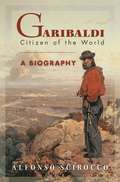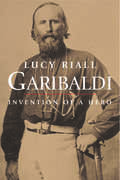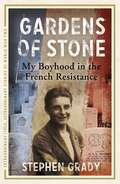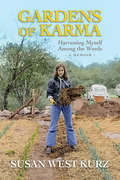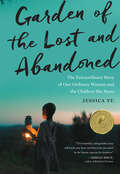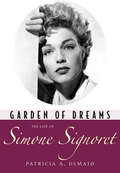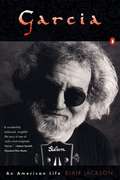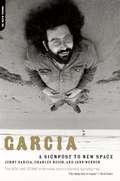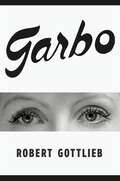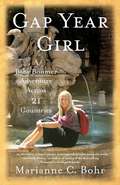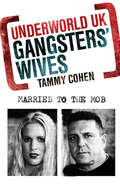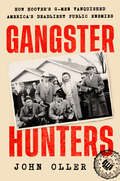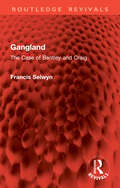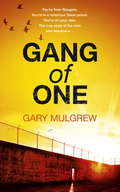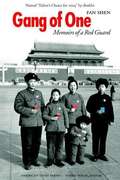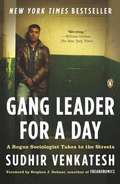- Table View
- List View
Garibaldi: Citizen of the World: A Biography
by Alfonso SciroccoWhat adventure novelist could have invented the life of Giuseppe Garibaldi? The revolutionary, soldier, politician, and greatest figure in the fight for Italian unification, Garibaldi (1807-1882) brought off almost as many dramatic exploits in the Americas as he did in Europe, becoming an international freedom fighter, earning the title of the "hero of two worlds," and making himself perhaps the most famous and beloved man of his century. Alfonso Scirocco's Garibaldi is the most up-to-date, authoritative, comprehensive, and convincing biography of Garibaldi yet written. In vivid narrative style and unprecedented detail, and drawing on many new sources that shed fresh light on important events, Scirocco tells the full story of Garibaldi's fascinating public and private life, separating its myth-like reality from the outright myths that have surrounded Garibaldi since his own day. Scirocco tells how Garibaldi devoted his energies to the liberation of Italians and other oppressed peoples. Sentenced to death for his role in an abortive Genoese insurrection in 1834, Garibaldi fled to South America, where he joined two successive fights for independence--Rio Grande do Sul's against Brazil and Uruguay's against Argentina. He returned to Italy in 1848 to again fight for Italian independence, leading seven more campaigns, including the spectacular capture of Sicily. During the American Civil War, Abraham Lincoln even offered to make him a general in the Union army. Presenting Garibaldi as a complex and even contradictory figure, Scirocco shows us the pacifist who spent much of his life fighting; the nationalist who advocated European unification; the republican who served a king; and the man who, although compared by contemporaries to Aeneas and Odysseus, refused honors and wealth and spent his last years as a farmer.
Garibaldi
by Lucy RiallGiuseppe Garibaldi, the Italian revolutionary leader and popular hero, was among the best-known figures of the nineteenth century. This book seeks to examine his life and the making of his cult, to assess its impact, and understand its surprising success.For thirty years Garibaldi was involved in every combative event in Italy. His greatest moment came in 1860, when he defended a revolution in Sicily and provoked the collapse of the Bourbon monarchy, the overthrow of papal power in central Italy, and the creation of the Italian nation state. It made him a global icon, representing strength, bravery, manliness, saintliness, and a spirit of adventure. Handsome, flamboyant, and sexually attractive, he was worshiped in life and became a cult figure after his death in 1882.Lucy Riall shows that the emerging cult of Garibaldi was initially conceived by revolutionaries intent on overthrowing the status quo, that it was also the result of a collaborative effort involving writers, artists, actors, and publishers, and that it became genuinely and enduringly popular among a broad public. The book demonstrates that Garibaldi played an integral part in fashioning and promoting himself as a new kind of "charismatic" political hero. It analyzes the way the Garibaldi myth has been harnessed both to legitimize and to challenge national political structures. And it identifies elements of Garibaldi's political style appropriated by political leaders around the world, including Mussolini and Che Guevara.
Gardens of Stone: My Boyhood in the French Resistance (Extraordinary Lives, Extraordinary Stories of World War Two #6)
by Michael Wright Stephen GradyAn extraordinary wartime memoir, combining the best kind of adventure story with a coming of age testimony of unforgettable resonance and poignancy.September 2011, Halkidiki, Northern Greece. A solitary 86 year-old man gazes across an Aegean headland, knowing that he must finally confront his past. He begins to write...September 1939, Nieppe, Northern France. 14 year-old Stephen is living with his family, 25 kilometres from Ypres. His French mother battles with her encroaching blindness. Failing to escape the advancing German army, his English father can no longer look after the war graves that cast so heartbreaking a shadow across the region. Stephen and his friend Marcel embark upon their great adventure: collecting souvenirs from strafed convoys and crashed Messerschmitts. But their world turns dark when arrested and imprisoned for sabotage and threatened with deportation or the firing squad. Upon his release, and still only 16, Stephen is recruited by the French Resistance. Growing up under the threat of imminent betrayal, he learns the arts of clandestine warfare, and - in a moment that haunts him still - how to kill... Such was the impact of Stephen Grady's work for the French Resistance, (especially during the countdown to D-Day and its bloody aftermath) that he was awarded the Croix de Guerre and the American Medal of Freedom.(P)2013 Hodder & Stoughton
Gardens of Stone: My Boyhood in the French Resistance
by Michael Wright Stephen GradyAn extraordinary wartime memoir, combining the best kind of adventure story with a coming of age testimony of unforgettable resonance and poignancy. September 2011, Halkidiki, Northern Greece. A solitary 86 year-old man gazes across an Aegean headland, knowing that he must finally confront his past. He begins to write... September 1939, Nieppe, Northern France. 14 year-old Stephen is living with his family, 25 kilometres from Ypres. His French mother battles with her encroaching blindness. Failing to escape the advancing German army, his English father can no longer look after the war graves that cast so heartbreaking a shadow across the region. Stephen and his friend Marcel embark upon their great adventure: collecting souvenirs from strafed convoys and crashed Messerschmitts. But their world turns dark when arrested and imprisoned for sabotage and threatened with deportation or the firing squad. Upon his release, and still only 16, Stephen is recruited by the French Resistance. Growing up under the threat of imminent betrayal, he learns the arts of clandestine warfare, and - in a moment that haunts him still - how to kill... Such was the impact of Stephen Grady's work for the French Resistance, (especially during the countdown to D-Day and its bloody aftermath) that he was awarded the Croix de Guerre and the American Medal of Freedom.
Gardens of Stone: My Boyhood In The French Resistance (Extraordinary Lives, Extraordinary Stories of World War Two #6)
by Michael Wright Stephen GradyAn extraordinary wartime memoir, combining the best kind of adventure story with a coming of age testimony of unforgettable resonance and poignancy. September 2011, Halkidiki, Northern Greece. A solitary 86 year-old man gazes across an Aegean headland, knowing that he must finally confront his past. He begins to write... September 1939, Nieppe, Northern France. 14 year-old Stephen is living with his family, 25 kilometres from Ypres. His French mother battles with her encroaching blindness. Failing to escape the advancing German army, his English father can no longer look after the war graves that cast so heartbreaking a shadow across the region. Stephen and his friend Marcel embark upon their great adventure: collecting souvenirs from strafed convoys and crashed Messerschmitts. But their world turns dark when arrested and imprisoned for sabotage and threatened with deportation or the firing squad. Upon his release, and still only 16, Stephen is recruited by the French Resistance. Growing up under the threat of imminent betrayal, he learns the arts of clandestine warfare, and - in a moment that haunts him still - how to kill... Such was the impact of Stephen Grady's work for the French Resistance, (especially during the countdown to D-Day and its bloody aftermath) that he was awarded the Croix de Guerre and the American Medal of Freedom.
Gardens of Karma: Harvesting Myself Among the Weeds, A Memoir
by Susan West KurzIt Began in a Simple Garden . . . and Led to a Spiritual Path. Susan West Kurz's earliest memories began in a garden, where she nurtured herbs and colorful flowers, nibbled sun-drenched vegetables and ripe berries, and danced with her doll, Pinocchio. Later, she landed in another garden, that one in Germany, where she shaped her budding interest into a hugely successful career for international organic and natural skin care products. But for decades, Susan was steeped in another role-one of enabler, support system, and overall back-up singer to the alcoholics who were center stage in her life. The pain of that disease ultimately led her to Anthroposophy, her spiritual path, where she soon recognized she had been headed all along. On her subsequent journey to health and freedom, Susan continues to find inner peace in a garden.
Garden of the Lost and Abandoned: The Extraordinary Story of One Ordinary Woman and the Children She Saves
by Jessica YuThe problem by most lights is overwhelming: at least 5,000 children live on the streets of Uganda&’s capital city of Kampala. Some forget the names of their villages. The youngest may not know the names of their parents. But Gladys Kalibbala—part journalist, part detective, part Good Samaritan—does not hesitate to dive into difficult or even dangerous situations to aid a child. Author of a newspaper column called &“Lost and Abandoned,&” she is a resource that police and others turn to when they stumble across a stranded kid with a hidden history. Jessica Yu delivers an acutely observed story of this hardnosed and warmhearted woman, the children she helps, and the twists of fate they experience together. The subplot of Gladys&’s garden—her precarious dream of providing a home and livelihood for her vulnerable charges—adds fascinating depth. Garden of the Lost and Abandoned chronicles one woman&’s altruism, both ordinary and extraordinary, in a way that is impossible to forget, and impossible not to take to heart.
Garden of Dreams: The Life of Simone Signoret (Hollywood Legends Series)
by Patricia A. DemaioThe incomparable Simone Signoret (1921-1985), one of the grand actresses of the twentieth century and one of France's most notable stars, considered herself the “oldest discovery” in Hollywood. After years of block-listing during the McCarthy era, she was thirty-eight years old when she entered Hollywood through the back door in the 1959 British blockbuster Room at the Top. Her portrayal of the endearing Alice Aisgill earned her the Academy Award in 1960, the first French actor to win a coveted Oscar. Though a latecomer to Hollywood, Signoret was already an international star who had survived the Nazi occupation of Paris, emerging in 1945 as a beautiful, promising actress capable of communicating more emotion through body language than dialogue alone could achieve. She gained a reputation as the thinking man's sex symbol and in several films portrayed prostitutes with subtlety and depth. She was fiercely protective of her privacy. But after winning the Oscar, she was dragged through the gutter when her second husband, Yves Montand, had a widely publicized affair with Marilyn Monroe. Many attributed her rapid aging and alcoholism to this betrayal. She endured this perception in silence, all the while demonstrating a remarkable capacity to reinvent herself as a bestselling author, respected social activist, and revered actress who remained in the cinema, her “garden of dreams,” for over four decades. Patricia A. DeMaio combines Signoret's courageous story with Montand's biography to reveal new information and insight into Signoret's humanitarian efforts and the vibrant film career that sustained her.
Garcia: An American Life
by Blair JacksonHe was there when Dylan went electric, when a generation danced naked at Woodstock, and when Ken Kesey started experimenting with acid. Jerry Garcia was one of the most gifted musicians of all time, and he was a member of one of the most worshiped rock 'n' roll bands in history. Now, Blair Jackson, who covered the Grateful Dead for twenty-five years, gives us an unparalleled portrait of Garcia--the musical genius, the brilliant songwriter, and ultimately, the tortured soul plagued by his own addiction. With more than forty photographs, many of them previously unpublished, Garcia: An American Life is the ultimate tribute to the man who, Bob Dylan said, "had no equal."
Garcia: A Signpost to New Space
by Jann Wenner Jerry Garcia Charles ReichJerry Garcia (1942-1995) is an American icon. The guitarist and de facto leader of the Grateful Dead was a gregarious talker, keenly engaged with the new world exploding around him. In 1972, Garcia was visited by Charles Reich, a Yale law professor, and Jann Wenner, the founder of Rolling Stone. Garcia was just thirty-one years old but already viewed--to his lasting dismay--as a social avatar for the new sensibility sweeping the land, an anarchist streak with a populist undercurrent that had roots in Ken Kesey's pranksters, the writers of the Beat Generation, and the libertine tradition of the American transcendentalists. In this interview, Garcia reveals how he is a combination of these and other influences, a high-school dropout and autodidact blessed with a gift for eloquent turns of phrase and a refreshing directness. He speaks of the saga of the Grateful Dead and his hoodlum youth growing up in San Francisco's Mission district. He delves into fascinating discourses on the music that shaped his own playing and writing, and freely discusses his use of drugs and explains why he felt it was important to stay high. Like the Grateful Dead's best music, Garcia: A Signpost to New Space is familiar, friendly, and inviting.
Garbo
by Robert GottliebA New York Times Book Review Editors' Choice | One of Literary Hub's most anticipated books of 2021Award-winning master critic Robert Gottlieb takes a singular and multifaceted look at the life of silver screen legend Greta Garbo, and the culture that worshiped her.“Wherever you look in the period between 1925 and 1941,” Robert Gottlieb writes in Garbo, “Greta Garbo is in people’s minds, hearts, and dreams.” Strikingly glamorous and famously inscrutable, she managed, in sixteen short years, to infiltrate the world’s subconscious; the end of her film career, when she was thirty-six, only made her more irresistible. Garbo appeared in just twenty-four Hollywood movies, yet her impact on the world—and that indescribable, transcendent presence she possessed—was rivaled only by Marilyn Monroe’s. She was looked on as a unique phenomenon, a sphinx, a myth, the most beautiful woman in the world, but in reality she was a Swedish peasant girl, uneducated, naïve, and always on her guard. When she arrived in Hollywood, aged nineteen, she spoke barely a word of English and was completely unprepared for the ferocious publicity that quickly adhered to her as, almost overnight, she became the world’s most famous actress.In Garbo, the acclaimed critic and editor Robert Gottlieb offers a vivid and thorough retelling of her life, beginning in the slums of Stockholm and proceeding through her years of struggling to elude the attention of the world—her desperate, futile striving to be “left alone.” He takes us through the films themselves, from M-G-M’s early presentation of her as a “vamp”—her overwhelming beauty drawing men to their doom, a formula she loathed—to the artistic heights of Camille and Ninotchka (“Garbo Laughs!”), by way of Anna Christie (“Garbo Talks!”), Mata Hari, and Grand Hotel. He examines her passive withdrawal from the movies, and the endless attempts to draw her back. And he sketches the life she led as a very wealthy woman in New York—“a hermit about town”—and the life she led in Europe among the Rothschilds and men like Onassis and Churchill. Her relationships with her famous co-star John Gilbert, with Cecil Beaton, with Leopold Stokowski, with Erich Maria Remarque, with George Schlee—were they consummated? Was she bisexual? Was she sexual at all? The whole world wanted to know—and still wants to know.In addition to offering his rich account of her life, Gottlieb, in what he calls “A Garbo Reader,” brings together a remarkable assembly of glimpses of Garbo from other people’s memoirs and interviews, ranging from Ingmar Bergman and Tallulah Bankhead to Roland Barthes; from literature (she turns up everywhere—in Hemingway’s For Whom the Bell Tolls, in Evelyn Waugh, Graham Greene, and the letters of Marianne Moore and Alice B. Toklas); from countless songs and cartoons and articles of merchandise. Most extraordinary of all are the pictures—250 or so ravishing movie stills, formal portraits, and revealing snapshots—all reproduced here in superb duotone. She had no personal vanity, no interest in clothes and make-up, yet the story of Garbo is essentially the story of a face and the camera. Forty years after her career ended, she was still being tormented by unrelenting paparazzi wherever she went.Includes Black-and-White Photographs
Gap Year Girl: A Baby Boomer Adventure Across 21 Countries
by Marianne C. BohrIn the 1960s and &’70s, thousands of baby boomers strapped packs to their backs and flocked to Europe, wandering the continent on missions of self-discovery. Many of these boomers still dream of &“going back&”—of once again cutting themselves free and revisiting the places they encountered in their youth, recapturing what was, and creating fresh memories along the way. Marianne Bohr and her husband, Joe, did just that. In Gap Year Girl, Bohr describes what it&’s like to kiss your job good-bye, sell your worldly possessions, pack your bags, and take off on a quest for adventure. Page by page, she engagingly recounts the experiences, epiphanies, highs, lows, struggles, surprises, and lessons learned as she and Joe journey as independent travelers on a budget—through medieval villages and bustling European cities, unimaginable culinary pleasures, and the entertaining (and sometimes infuriating) characters encountered along the way. Touching on universal themes of escape, adventure, freedom, discovery, and life reimagined, Gap Year Girl is an exciting account of a couple&’s experiences on an unconventional, past the-blush-of-youth journey.
Gangsters' Wives
by Tammy CohenBehind every good man is a good woman. But what lies behind every bad man? Gangsters' Wives tells the side of the story you didn't know--what it's like to live with Britain's most lawless men, from the women who married them.Devoted mum-of-three Judy Marks was imprisoned alongside her husband, notorious drug smuggler Howard Marks; while Flanagan, the first ever Page Three girl, found herself splashed across the papers as the fiancee of legendary East End villain Reggie Kray. Jenny Pinto, wife of gangster Dave Courtney, has given the police keys to their house to stop them breaking down the front door.In ten funny, moving, searingly honest first-person accounts, Gangsters' Wives tells you all you ever wanted to know about the lives and loves of the women who are, quite literally, married to the mob.
Gangsters Without Borders: An Ethnography of a Salvadoran Street Gang (Issues of Globalization: Case Studies in Contemporary Anthropology)
by T. W. Ward<p>Based on author T.W. Ward's eight and a half years in Los Angeles conducting participant observation with MS-13, Gangsters Without Borders: An Ethnography of a Salvadoran Street Gang takes an inside look at gang life in the United States and in a global context. <p>Taking us through their journey from their homeland in El Salvador to the mean streets of Los Angeles, Gangsters Without Borders offers a perspective from the point of view of the hard-core members who live this hard, fast, and dangerous life. <p>A powerful and engaging overview of gang dynamics, Gangsters Without Borders contextualizes the sources and severity of the marginalization felt by Salvadoran immigrants and debunks myths about street gangs in the United States. This account of gangster's lives before, during, and after their involvement with the gang, delivers an intimate and analytical portrait unlike any other.</p>
Gangster Hunters: How Hoover's G-men Vanquished America's Deadliest Public Enemies
by John OllerThe enthralling, can't-put-down account of the birth of the modern FBI.J. Edgar Hoover was the face of the FBI. But the federal agents in the field, relentlessly chasing the most notorious gangsters of the 1930s with their own lives on the line, truly transformed the Bureau. In 1932, the FBI lacked jurisdiction over murder cases, bank robberies, and kidnappings. Relegated to the sidelines, agents spent their days at their desks. But all of that changed during the War on Crime. Hunting down infamous public enemies in tense, frequently blood-soaked shootouts, the Bureau was thrust onto the front pages for the first time.Young agents, fresh out of law school and anticipating a quiet, white-collar job, faced off with murderous felons who were heavily armed, clad in bulletproof vests, and owned cars that outraced the best vehicles the Bureau had. But the federal men were fiercely devoted—to the Bureau, to each other, and to bringing America&’s most wanted criminals to justice.The G-men crisscrossed the United States in pursuit of John Dillinger, Bonnie and Clyde, Ma Barker's criminal family, Baby Face Nelson, and Pretty Boy Floyd. But the green FBI agents were always one step behind and a moment too late, the criminals evading elaborate stakeouts and dramatic ambushes. Facing mounting criticism, with bodies left in their wake, the agents had to learn to adapt. After all, more than their reputations were at stake. Through incredible primary source research, John Oller transports readers right to the most harrowing and consequential raids of the 1930s, with fast-paced action that shows the lengths both sides would go to win.
Gangs in Garden City: How Immigration, Segregation, and Youth Violence are Changing America's Suburbs
by Sarah GarlandFor the past five years, journalist Sarah Garland has followed the lives of current and former gang members living in Hempstead on the border of Garden City, Long Island. Affiliated with Mara Salvatrucha and 18th Street, their troubling personal stories expose the cruel realities of segregation, racial income gaps, and poverty that lie hidden behind suburban white picket fences. As Garland travels from Los Angeles to El Salvador and back to the East Coast, she reveals a disturbing cycle of poverty in which families, fleeing from troubled Central American cities, move into America’s suburban backyards, only to find the pattern of violence repeating itself. Brilliantly reported and sensitively told,Gangs in Garden Citydraws back the veil on a hidden, troubling world.
Gangland: The Case of Bentley and Craig (Routledge Revivals)
by Francis SelwynOn the evening of 2nd November 1952, a shot fired from a makeshift weapon on a warehouse roof in Croydon killed PC Sidney Miles. Next morning the newspaper headlines proclaimed a Chicago gun-battle in London, gangsters machine-gunning armed police over the rooftops.But the trial of Bentley and Craig affronted common sense and alienated a generation raised in the post-war suburbia of cinemas, coffee bars and drab streets. How could Derek Bentley, nineteen and with learning difficulties, be hanged for a murder committed a quarter of an hour after he was arrested? Lord Chief Justice Goddard and the Home Secretary, Sir David Maxwell Fyfe, found a way. The nation was split into those determined to teach young thugs a lesson and those dismayed by an act of judicial murder. The execution of Bentley, wrote Kenneth Allsop in Picture Post, caused an emotional upset in England comparable only to Dunkirk and the death of George VI.Originally published in 1988, Gangland evokes the high drama of those weeks in the autumn of 1952. The moral authoritarianism of the Churchill government was backed by Lord Goddard’s zeal for hanging and flogging, by women’s groups demanding tougher sentences and corporal punishment, by a popular press which portrayed society under threat from cosh-boys and teenage gunmen, flick knives and horror comics, violence on the cinema screen and the printed page.Against this the demonstrators packed Whitehall, chanting ‘Bentley must not die!’ Others pointed out that violent crime was falling rather than rising. Bentley went to his death and thereby perhaps did more to discredit capital punishment than anyone. The facts of the case, including hysteria over sex and violence in the media and the clamour over rising crime which helped to ensure his execution, have a relevance to all periods of history – not least our own.
Gang of One: One Man's Incredible Battle to Find his Missing Daughter
by Gary MulgrewGANG OF ONE is the remarkable true story of one man's journey from a Glasgow orphanage to a notorious gang-infested prison in Texas. Driven by his desire to return to his son in England and haunted by the increasingly frustrating search for his missing daughter, Gary Mulgrew attempts the impossible task of surviving the prison's gang culture. Told with wit and humanity, GANG OF ONE shows a man constantly confronted by the moral and physical challenges of prison life, where everyone is encouraged to turn their back and 'see nuthin''. Gary's choice - to walk away and let a man die, or intervene and lose the chance to get home - makes GANG OF ONE a book as unforgettable as it is enthralling.
Gang of One: One Man's Incredible Battle to Find his Missing Daughter
by Gary MulgrewGANG OF ONE is the remarkable true story of one man's journey from a Glasgow orphanage to a notorious gang-infested prison in Texas. Driven by his desire to return to his son in England and haunted by the increasingly frustrating search for his missing daughter, Gary Mulgrew attempts the impossible task of surviving the prison's gang culture. Told with wit and humanity, GANG OF ONE shows a man constantly confronted by the moral and physical challenges of prison life, where everyone is encouraged to turn their back and 'see nuthin''. Gary's choice - to walk away and let a man die, or intervene and lose the chance to get home - makes GANG OF ONE a book as unforgettable as it is enthralling.
Gang of One: Memoirs of a Red Guard
by Fan ShenIn 1966 twelve-year-old Fan Shen, a newly minted Red Guard, plunged happily into China's Cultural Revolution. Disillusion soon followed, then turned to disgust and fear when Shen discovered that his compatriots had tortured and murdered a doctor whose house he'd helped raid and whose beautiful daughter he secretly adored. A story of coming of age in the midst of monumental historical upheaval, Shen's Gang of One is more than a memoir of one young man's harrowing experience during a time of terror. It is also, in spite of circumstances of remarkable grimness and injustice, an unlikely picaresque tale of adventure full of courage, cunning, wit, tenacity, resourcefulness, and sheer luck--the story of how Shen managed to scheme his way through a hugely oppressive system and emerge triumphant. Gang of One recounts how Shen escaped, again and again, from his appointed fate, as when he somehow found himself a doctor at sixteen and even, miraculously, saved a few lives. In such volatile times, however, good luck could quickly turn to misfortune: a transfer to the East Wind Aircraft Factory got him out of the countryside and into another terrible trap, where many people were driven to suicide; his secret self-education took him from the factory to college, where friendship with an American teacher earned him the wrath of the secret police. Following a path strewn with perils and pitfalls, twists and surprises worthy of Dickens, Shen's story is ultimately an exuberant human comedy unlike any other.
Gang Leader for a Day
by Sudhir VenkateshA New York Times BestsellerForeword by Stephen J. Dubner, coauthor of FreakonomicsWhen first-year graduate student Sudhir Venkatesh walked into an abandoned building in one of Chicago's most notorious housing projects, he hoped to find a few people willing to take a multiple-choice survey on urban poverty--and impress his professors with his boldness. He never imagined that as a result of this assignment he would befriend a gang leader named JT and spend the better part of a decade embedded inside the projects under JT's protection. From a privileged position of unprecedented access, Venkatesh observed JT and the rest of his gang as they operated their crack-selling business, made peace with their neighbors, evaded the law, and rose up or fell within the ranks of the gang's complex hierarchical structure. Examining the morally ambiguous, highly intricate, and often corrupt struggle to survive in an urban war zone, Gang Leader for a Day also tells the story of the complicated friendship that develops between Venkatesh and JT--two young and ambitious men a universe apart."Riveting." --The New York Times"Compelling... dramatic... Venkatesh gives readers a window into a way of life that few Americans understand." --Newsweek"An eye-opening account into an underserved city within the city." --Chicago Tribune"The achievement of Gang Leader for a Day is to give the dry statistics a raw, beating heart." --The Boston Globe"A rich portrait of the urban poor, drawn not from statistics but from viivd tales of their lives and his, and how they intertwined." --The Economist"A sensative, sympathetic, unpatronizing portrayal of lives that are ususally ignored or lumped into ill-defined stereotype." --Finanical TimesSudhir Venkatesh's latest book Floating City: A Rogue Sociologist Lost and Found in New York's Underground Economy--a memoir of sociological investigation revealing the true face of America's most diverse city--was published in September 2013 by The Penguin Press
Gandhinvishyee Khand 2 - Gandhivichar aani Samakaleen Vicharvishwa: गांधींविषयी खंड २ - गांधीविचार आणि समकालीन विचारविश्व
by Ashok Chausalkarगांधी विचार आणि समकालीन विचारविश्व या पुस्तकात महात्मा गांधींच्या तत्त्वज्ञानाचा आणि त्यांच्या समकालीन विचारवंतांशी असलेल्या नातेसंबंधांचा विविध अंगांनी अभ्यास केलेला आहे. तीन खंडांमध्ये विभागलेले हे पुस्तक गांधींच्या तत्त्वज्ञानाचा तुलनात्मक आणि सखोल अभ्यास मांडते. पहिला खंड गांधींच्या व्यक्तिमत्त्वाचा, त्यांच्या कार्याचा आणि विचारांचा वेध घेतो, तर दुसऱ्या खंडात गांधींचा सॉक्रेटिस, टॉलस्टॉय, मार्क्स, गोखले, टिळक यांसारख्या विचारवंतांशी असलेला अनुबंध अभ्यासला आहे. तिसऱ्या खंडात गांधींच्या तत्त्वज्ञानाचा संदर्भ सामाजिक परिवर्तन, शाश्वत विकास, पर्यावरण, शिक्षण यांसारख्या आधुनिक विषयांशी जोडला आहे. संपादक अशोक चौसाळकर यांच्या मार्गदर्शनाखाली या ग्रंथाने गांधी विचारांची व्यापक संदर्भ चौकट उभी केली आहे. पुस्तकातून गांधींच्या सत्य, अहिंसा आणि समाजवादाच्या विचारांवर विशेष भर देण्यात आला आहे, ज्यामुळे आजच्या काळातील सामाजिक, राजकीय आणि आर्थिक समस्यांवर एकात्मिक दृष्टिकोन देण्याचा प्रयत्न झाला आहे.
Gandhinvishyee Khand 1 - Gandhi Jeevan aani Karya: गांधींविषयी खंड १ - गांधी जीवन आणि कार्य
by Kishor Bedkihal"गांधींविषयी" खंड १, २ आणि ३ या त्रिखंडात्मक ग्रंथमालेत महात्मा गांधींच्या जीवन, कार्य आणि तत्त्वज्ञानाचा व्यापक वेध घेतला आहे. पहिल्या खंडात गांधींच्या जीवनप्रवासाचे, त्यांच्या सत्याग्रह, अहिंसा, आणि समता यांसारख्या मूलभूत तत्त्वज्ञानाचे सविस्तर विवेचन आहे. गांधींनी समाजातील शेवटच्या व्यक्तीपर्यंत न्याय पोहोचवण्यासाठी केलेल्या प्रयत्नांचा व त्यांच्या कार्याच्या परिणामांचा अभ्यासही यात आहे. दुसऱ्या खंडात गांधींच्या तत्त्वज्ञानाचा तुलनात्मक अभ्यास सॉक्रेटिस, टॉलस्टॉय, टागोर, आणि गोखल्यांसारख्या विविध व्यक्तींशी केला आहे. त्यांच्या वैचारिक वादविवादांतून गांधींच्या विचारधारेला आलेली प्रगल्भता स्पष्ट होते. तिसऱ्या खंडात गांधी विचारांची वर्तमानकाळातील उपयुक्तता, सामाजिक-आर्थिक बदलांच्या संदर्भात त्यांचे महत्त्व, आणि पर्यावरण, तंत्रज्ञान यांसारख्या विषयांवरील त्यांच्या दृष्टिकोनाची चर्चा आहे. या ग्रंथमालेत गांधींच्या विचारांचे बहुआयामी पैलू उलगडत असून, त्यांच्या विचारांमधून वर्तमानकाळातील आव्हानांवर उपाय शोधण्याचा प्रयत्न केला आहे. गांधींचे कार्य केवळ ऐतिहासिकदृष्ट्या महत्त्वाचे नाही, तर ते भविष्यातील मानवी समाजासाठीही दीपस्तंभ ठरू शकते, हे या ग्रंथातून अधोरेखित होते.
Gandhijiyin Irudhi 200 Naatkal: காந்திஜியின் இறுதி 200 நாட்கள்
by V. Ramamurthyஇந்நூலில் காந்திஜியின் கடைசி 200 நாட்கள் ஆவணப்படுத்தப்பட்டிருக்கின்றன. மேலும் அவர் தன்னுடைய கடைசி 200 நாட்களில் மக்களுக்காக எவ்வளவு பாடுபட்டார் என்பதை பற்றி வி. ராமமூர்த்தி மிகவும் அவர்கள் மிகுந்த பொறுப்புணர்வுடன் கூறியுள்ளார்.
Gandhijinu Jivan — Emnaj Shabdoma
by Krishna Kruplaniહું મારા ઘરની આસપાસ દીવાલ ચણી લેવા તથા મારી બારીઓ બંધ કરી દેવા નથી માગતો. મારા ઘરની આસપાસ સઘળા દેશોની સંસ્કૃતિના પવનની લહેરીઓ છૂટથી વાતી રહે એમ હું ઇચ્છું છું. પણ પવનની એવી કોઈ લહરી દ્વારા જમીનથી અધ્ધર થઈ જવાનો હું ઇનકાર કરું છું. સાહિત્યમાં રસ ધરાવતાં આપણાં તરુણ સ્ત્રીપુરુષો અંગ્રેજી ભાષા તેમ જ બીજી વિશ્વભાષાઓ પેટ ભરીને શીખે એમ હું ઇચ્છું છું. અને પછી તેઓ જગદીશચંદ્ર બોઝ, પ્રફુલ્લચંદ્ર રોય અને કવિવર રવીન્દ્રનાથ ટાગોરની પેઠે પોતાના અભ્યાસનો લાભ હિંદને તથા દુનિયાને આપે એવી તેમની પાસેથી અપેક્ષા રાખું. પરંતુ એક પણ હિંદવાસી પોતાની માતૃભાષાને ભૂલે, તેની અવગણના કરે કે તેનાથી શરમાય અથવા પોતાની માતૃભાષામાં પોતે વિચાર કરી શકતો નથી કે પોતાના વિચારો સારામાં સારી રીતે દર્શાવી શકતો નથી એમ તેને લાગે, એમ હું ઇચ્છતો નથી. મારો ધર્મ ચોકાપંથી નથી. — ગાંધીજી
